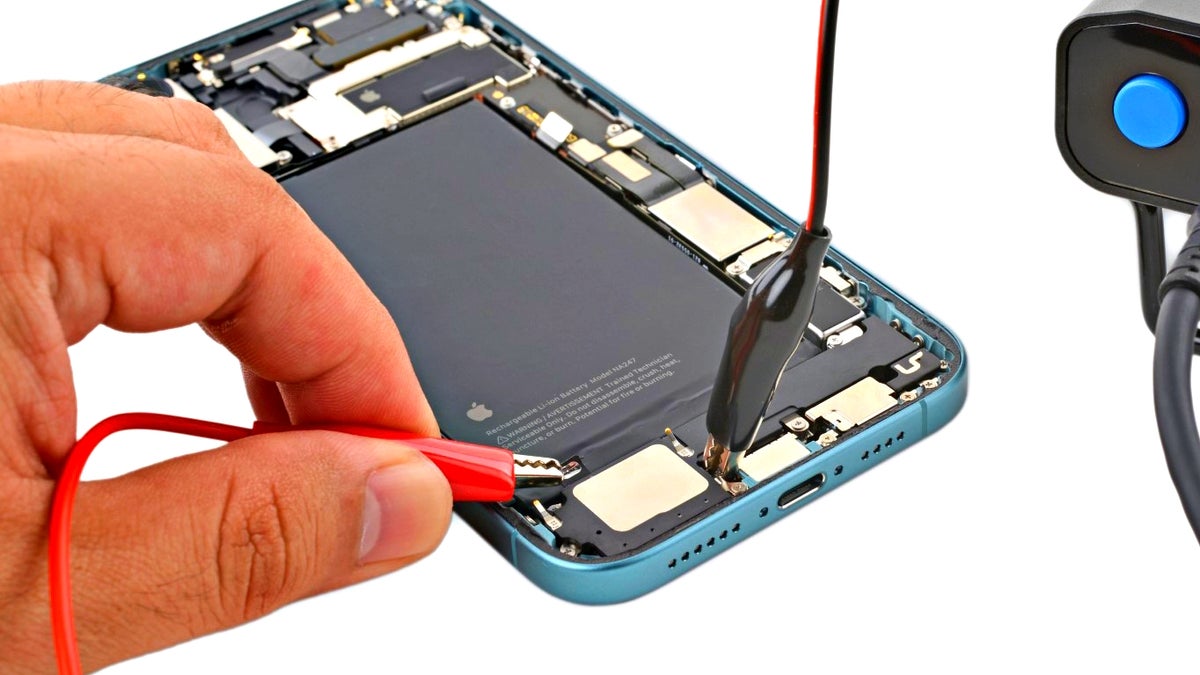iPhone 16 most easily repairable iPhone in ages - Samsung and Google to follow in Apple’s footsteps?
This article may contain personal views and opinion from the author.

Thanks to the latest iFixit teardown video, we now know that the iPhone 16 makes changing your battery much easier than before - thanks to a surprisingly genius internal design update by Apple.
Make no mistake - the positive change is influenced by the new European laws that say phone makers need to make batteries easier to replace - I suppose Apple is just using the iPhone 16 and iPhone 16 Plus as the testing ground for the inevitable update.
Apple’s solution? Adding a special adhesive that comes off with the help of electric current. What?! Although it might sound complicated, all you need to know is that this trick can be performed with a 9V battery or even power from a USB-C cable. The higher the current - the faster the adhesive will detach from the back of your iPhone.

This makes iPhone 16 and iPhone 16 Plus’ score of 7/10 a huge improvement - and it’s all thanks to the easily removable battery and Apple’s decision to put an end to the whole part pairing thing - apart from Face ID - supposedly due to security reasons.

Why is that little detail about the new method of removing the battery of your iPhone 16 so important? Well, in 3-4 years time when it doesn’t last as long as it used to, you’d be able to replace the battery of your iPhone 16 in no more than 5-10 minutes, using accessible tools.
This move makes the iPhone 16 series some of the most easily repairable mainstream phones, which should push big players like Samsung, Google, and all Chinese phone-makers to level up their repairability game ASAP.
Apple is known as the trendsetter in the smartphone industry - the latest proof of that are the various versions of the Camera Control buttons expected to start showing up in Android phones as soon as this year.

Although it might sound like a boring aspect of phone-making, repairability plays a massive role in how durable and long-lasting a phone is.
This is especially important because recent trends show that people like keeping their expensive phones for longer than before. And while a phone with a 1-2 year old battery should still be in a good enough condition to last a whole day, this certainly wouldn’t be the case with a 3-5 year old phone.

With all that in mind, iPhone 16 is still far from being an easily-repairable phone when not examined in isolation.
That’s because some of HMD’s latest mid-range phones like the HMD Skyline give you access to the back of your phone by removing a single screw.
Ironically, HMD has glued the battery of the Skyline to the back of the phone just like on the iPhone 16 Pro models, which makes the whole effort to make the back removable pretty confusing.
In other words, Apple still has a long way to go before being able to proudly claim their phones are truly easy to repair.
Make no mistake - the positive change is influenced by the new European laws that say phone makers need to make batteries easier to replace - I suppose Apple is just using the iPhone 16 and iPhone 16 Plus as the testing ground for the inevitable update.

iFixit iPhone 16 teardown.
I remember the times when iPhone 14 and iPhone 15 would get a score of 4/10 from iFixit due to Apple’s controversial decision to make using different/unoriginal iPhone parts impossible by pairing your iPhone’s parts to your particular iPhone unit (using serial numbers).
This makes iPhone 16 and iPhone 16 Plus’ score of 7/10 a huge improvement - and it’s all thanks to the easily removable battery and Apple’s decision to put an end to the whole part pairing thing - apart from Face ID - supposedly due to security reasons.
Improved reparability might be the biggest iPhone 16 selling point that no one is talking about - but the iPhone 16 Pro models aren’t as easily repairable

iFixit iPhone 15 teardown.
Unfortunately, the easily removable battery is exclusive to the iPhone 16 and iPhone 16 Plus models - the Pro models still get adhesive pull tabs for whatever reason. To make things even more confusing, only the 6.3-inch iPhone 16 Pro gets a metal case on its battery - supposedly for better heat dissipation and safer repairs. But why not all iPhone 16 models, Apple?!
Why is that little detail about the new method of removing the battery of your iPhone 16 so important? Well, in 3-4 years time when it doesn’t last as long as it used to, you’d be able to replace the battery of your iPhone 16 in no more than 5-10 minutes, using accessible tools.
Apple is known as the trendsetter in the smartphone industry - the latest proof of that are the various versions of the Camera Control buttons expected to start showing up in Android phones as soon as this year.

Although it might sound like a boring aspect of phone-making, repairability plays a massive role in how durable and long-lasting a phone is.
This is especially important because recent trends show that people like keeping their expensive phones for longer than before. And while a phone with a 1-2 year old battery should still be in a good enough condition to last a whole day, this certainly wouldn’t be the case with a 3-5 year old phone.
Hence, the idea of taking 5 minutes to swap out your battery and make your phone last as long as on day one sounds extremely appealing. For instance, some members of my family are currently using 4-5 year old phones like the Galaxy S9, and the main reason they need new phones is battery life.
Yes, you can swap out your iPhone 16's battery in a few minutes but Apple, Samsung, and Google still have a long way to go

iFixit iPhone 14 teardown.
That’s because some of HMD’s latest mid-range phones like the HMD Skyline give you access to the back of your phone by removing a single screw.
Ironically, HMD has glued the battery of the Skyline to the back of the phone just like on the iPhone 16 Pro models, which makes the whole effort to make the back removable pretty confusing.
In other words, Apple still has a long way to go before being able to proudly claim their phones are truly easy to repair.
Not to mention (and I’m asking again), why is the new battery design exclusive to the iPhone 16 and iPhone 16 Plus, Apple?! And why is only the 6.3-inch iPhone 16 Pro getting a metal case for its battery?
- Apart from that, how about moving on from using glass backs to hard plastic or metal ones?
- Opening up your iPhone still requires external tools (not provided in the box) - glued parts should make way to something better
- Some spare parts like displays and glass backs are incredibly expensive, making some repairs costlier than buying a new mid-range phone; big players can take note from HMD - the company sells spare parts on the cheap compared to the like of Apple, Samsung, and Google
Follow us on Google News














Things that are NOT allowed:
To help keep our community safe and free from spam, we apply temporary limits to newly created accounts: